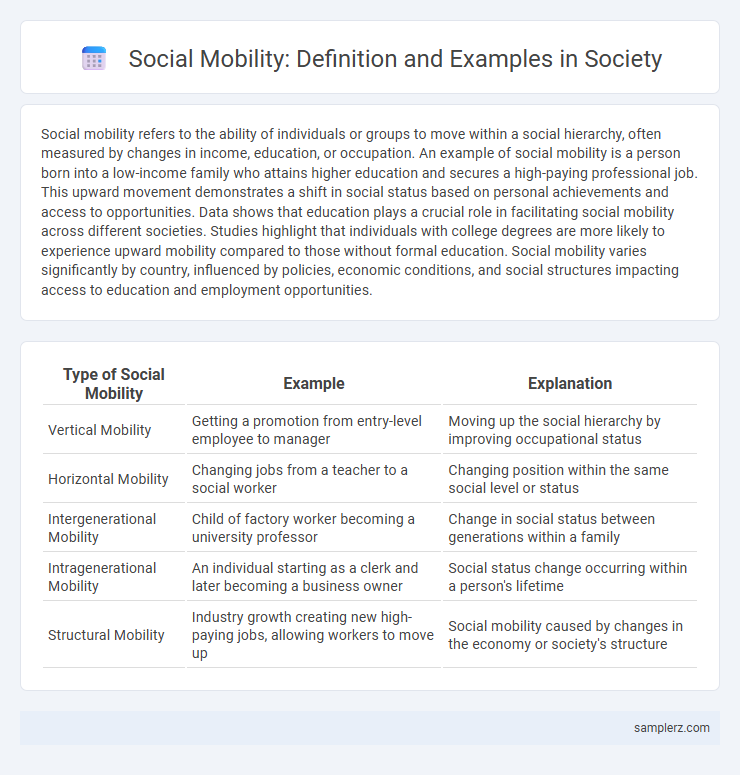Social mobility refers to the ability of individuals or groups to move within a social hierarchy, often measured by changes in income, education, or occupation. An example of social mobility is a person born into a low-income family who attains higher education and secures a high-paying professional job. This upward movement demonstrates a shift in social status based on personal achievements and access to opportunities. Data shows that education plays a crucial role in facilitating social mobility across different societies. Studies highlight that individuals with college degrees are more likely to experience upward mobility compared to those without formal education. Social mobility varies significantly by country, influenced by policies, economic conditions, and social structures impacting access to education and employment opportunities.
Table of Comparison
| Type of Social Mobility | Example | Explanation |
|---|---|---|
| Vertical Mobility | Getting a promotion from entry-level employee to manager | Moving up the social hierarchy by improving occupational status |
| Horizontal Mobility | Changing jobs from a teacher to a social worker | Changing position within the same social level or status |
| Intergenerational Mobility | Child of factory worker becoming a university professor | Change in social status between generations within a family |
| Intragenerational Mobility | An individual starting as a clerk and later becoming a business owner | Social status change occurring within a person's lifetime |
| Structural Mobility | Industry growth creating new high-paying jobs, allowing workers to move up | Social mobility caused by changes in the economy or society's structure |
Classic Case Studies of Social Mobility
Classic case studies of social mobility highlight how individuals from working-class backgrounds attain higher socioeconomic status through education and career advancement. The research on the American Dream exemplifies upward mobility, where meritocratic values enable first-generation college students to secure professional occupations. Similarly, the study of the British class system reveals intergenerational shifts, with some families transcending traditional class boundaries through employment in emerging service industries.
Upward Mobility: Stories of Rising from Poverty
Upward mobility is exemplified by individuals who overcome poverty through education and entrepreneurship, such as first-generation college graduates who secure high-paying jobs. Programs like scholarships and vocational training empower marginalized communities to break the cycle of poverty. Real-life success stories highlight the transformative impact of social support systems and economic opportunities on rising socioeconomic status.
Downward Mobility: When Status is Lost
Downward mobility occurs when individuals or groups experience a decline in social status due to job loss, financial hardship, or changes in family circumstances. For example, a middle-class professional facing unemployment may move into lower socioeconomic brackets, impacting access to education and healthcare. This loss of status often leads to diminished social capital and reduced opportunities for upward movement.
Education as a Catalyst for Social Mobility
Education serves as a powerful catalyst for social mobility by equipping individuals from disadvantaged backgrounds with essential skills and knowledge to access better employment opportunities. Studies show that higher educational attainment significantly increases lifetime earnings and reduces poverty rates. Investment in quality education and scholarships for underserved communities fosters equitable upward mobility and narrows socioeconomic disparities.
The Role of Occupation in Social Mobility
Occupation serves as a critical driver of social mobility by determining income levels, social status, and access to resources that influence upward or downward movement within social hierarchies. For example, transitioning from a manual labor position to a professional occupation typically enhances economic stability and societal prestige, facilitating improved living standards and educational opportunities for subsequent generations. Research consistently shows that occupational shifts significantly impact intergenerational mobility, highlighting the vital role of career advancement in reshaping social class structures.
Social Mobility Across Generations
Social mobility across generations is exemplified by families improving their socioeconomic status through education and career opportunities. Children of working-class parents attending college and securing professional jobs demonstrate upward intergenerational mobility. Such progress reflects changes in access to resources and social capital over time.
Geographic Relocation and Social Mobility
Geographic relocation significantly influences social mobility by providing individuals access to better education, job opportunities, and social networks. Migrating from rural to urban areas often leads to improved socioeconomic status and enhanced quality of life. This spatial movement enables upward mobility by breaking the constraints of local economic limitations and expanding exposure to diverse cultural and professional environments.
Impact of Marriage on Social Mobility
Marriage plays a critical role in social mobility by enabling individuals to access new social networks and economic opportunities through spousal connections. Studies show that marrying into a higher socioeconomic status family can significantly improve upward mobility, especially by increasing household income and access to education. Furthermore, intermarriage across social classes often reduces social stratification by blending resources and cultural capital.
Barriers to Social Mobility in Modern Society
Barriers to social mobility in modern society include unequal access to quality education, which limits opportunities for individuals from lower socioeconomic backgrounds. Discrimination based on race, gender, or class further entrenches social inequalities and restricts upward movement. Economic instability and limited social networks also hinder individuals' ability to improve their social status.
Government Policies that Enhance Social Mobility
Government policies such as progressive taxation, affordable housing programs, and expanded access to quality education significantly enhance social mobility by reducing economic barriers and creating equal opportunities. Investments in workforce development and social safety nets enable lower-income individuals to gain skills and resources essential for upward mobility. Targeted initiatives like scholarship schemes, minimum wage laws, and anti-discrimination regulations foster an inclusive environment where social mobility is attainable across diverse populations.

example of social mobility in social Infographic
 samplerz.com
samplerz.com